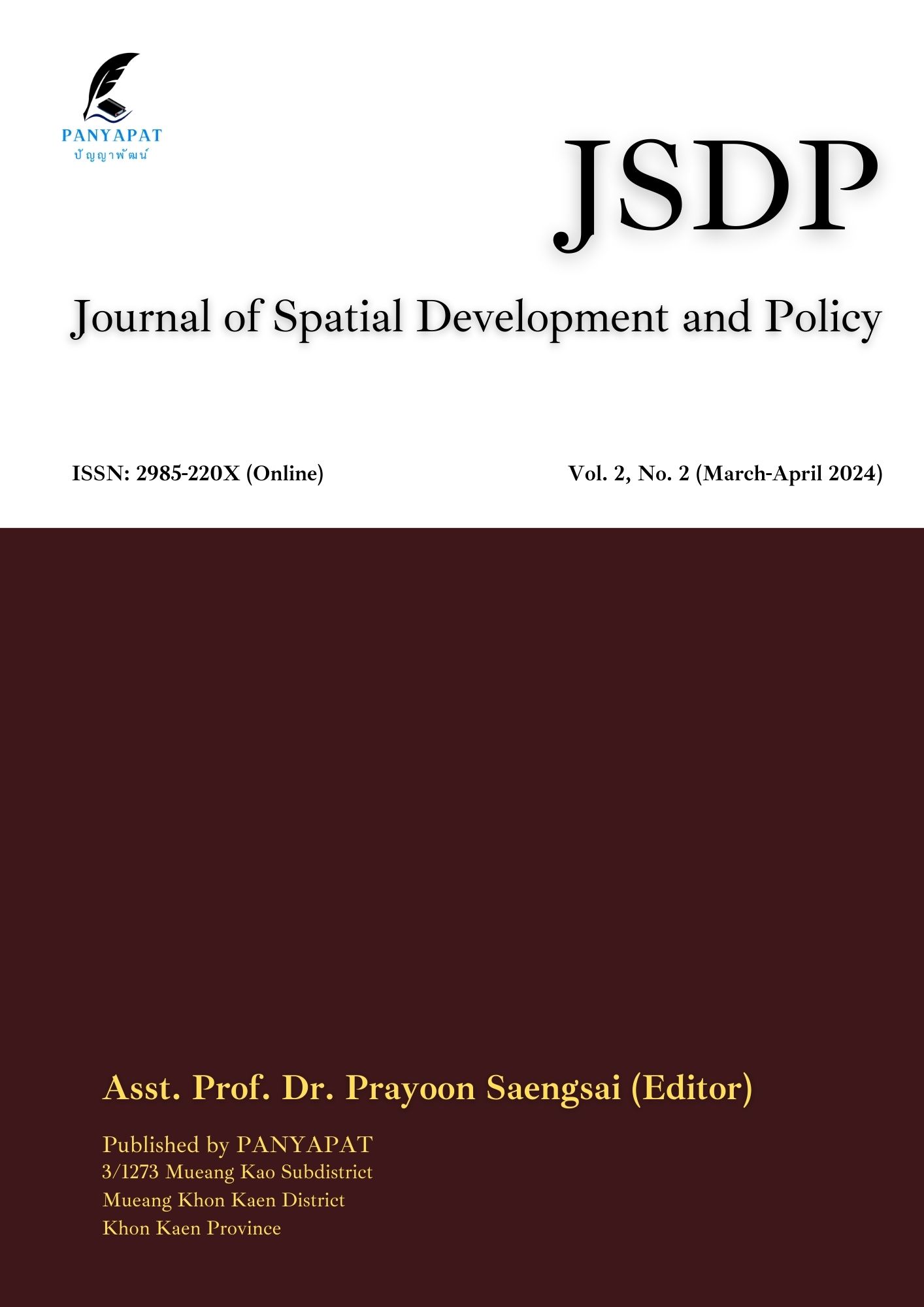Wagon: Ancient Transport Vehicle to Ruins in Modern Museum
Main Article Content
Abstract
This academic article aims to present past and present changes in the land transport system. The wagon was an important vehicle of transportation and travel in ancient times, and its ruins are on display in the museum in the present day. The most important travel route in ancient times was the "Wagon Path" which was used as a link to travel back and forth to trade and exchange goods with each other. Wagons are valuable, expensive vehicles with a high demand for ownership. It is a tool to show luxury and social wealth. It is a transport vehicle for city-to-city trade, and is important for traveling, migrating, making food It is a place to live, sleep, relax, escape the sun, escape the rain, etc. In this modern era, there has been development of land transportation infrastructure from the government, making roads for transportation and travel more convenient. There are main routes and secondary routes connecting all over the country. Most people have adapted to the changing times. By turning to cars or trucks for transportation and travel. Carts and ox carts gradually, it loses its importance as a vehicle for transportation and travel. The bullock carts were sold to slaughterhouses. The wagons were sold as home decorations. and displayed in museums to be a learning medium for people in today's era.
Article Details

This work is licensed under a Creative Commons Attribution-NonCommercial-NoDerivatives 4.0 International License.
References
กรมทางหลวง. (2560). ระบบหมายเลขทางหลวง. สืบค้น 20 กุมภาพันธ์ 2567. จาก https://shorturl.asia/dAmbl.
กรมทางหลวงชนบท. (2567). ความเป็นมาของกรมทางหลวงชนบท. สืบค้น 20 กุมภาพันธ์ 2567. จาก https://drr.go.th/?page_id=15.
กัลยาณี ถนอมแก้ว. (2564). ถนนทุกสายมุ่งสู่กรุงโรม. สืบค้น 20 กุมภาพันธ์ 2567. จาก https://www.gotoknow.org/posts/692266.
การรถไฟแห่งประเทศไทย. (2566). ประวัติการรถไฟแห่งประเทศไทย. สืบค้น 20 กุมภาพันธ์ 2567. จาก https://shorturl.asia/X0V5j.
ชิลวี มาดดาลีนา ฮอลลิงกา. (2524). การจัดการชลประทานในรัชสมัยพระบาทสมเด็จพระจุลจอมเกล้าเจ้าอยู่หัว. กรุงเทพฯ: มูลนิธิโครงการตำราสังคมศาสตร์และมนุษยศาสตร์.
ชุตินันท์ ทองคำ. (2556). การค้าแบบกองเกวียน ณ เมืองนครราชสีมา. สืบค้น 20 กุมภาพันธ์ 2567. จาก https://www.gotoknow.org/posts/551148.
ชูสิทธิ์ ชูชาติ. (2545). พ่อค้าวัวต่าง : ผู้บุกเบิกการค้าขายในหมู่บ้านภาคเหนือของประเทศไทย (พ.ศ.2389-2503). กรุงเทพฯ: ศูนย์ศึกษาภูมิปัญญาท้องถิ่น.
เชียงใหม่นิวส์. (2562). “วัวล้อ” ขบวนเกวียนขนส่งสินค้าในอดีตเมื่อ 50 ปีก่อน. สืบค้น 20 กุมภาพันธ์ 2567. จาก https://www.chiangmainews.co.th/page/archives/895581#google_vignette.
ณัฐวุฒิ ปรียวนิตย์. (2560). เศรษฐกิจการเมืองของการตัดถนนในพระนคร สมัยรัชการที่ 1-5. กรุงเทพฯ: คณะสถาปัตยกรรมศาสตร์ มหาวิทยาลัยศิลปากร.
ติ๊ก แสนบุญ. (2566). “เกวียนอีสาน” ผสานวิถีชีวิตและภูมิปัญญาลีลาช่างจนมีลักษณะสวยงามกว่าเกวียนภาคอื่น. สืบค้น 20 กุมภาพันธ์ 2567. จาก https://www.silpa-mag.com/culture/article_77435
ไทยรัฐออนไลน์. (2553). พระอัจฉริยะเรื่องน้ำของ ร.5. สืบค้น 20 กุมภาพันธ์ 2567. จาก https://www.thairath.co.th/news/politic/120841.
ธวัชชัย ทำทอง. (2564). ช่างทำเกวียน. สืบค้น 20 กุมภาพันธ์ 2567. จาก https://shorturl.asia/5p8H0.
นักรบ มูลมานัส. (2561). กรุงเทพฯ ราตรี จุดเริ่มต้นการท่องราตรีของชาวกรุงรุ่นปู่ย่าตาทวดที่มาพร้อมการตัดถนน รถราง ไฟฟ้า และรถยนต์. สืบค้น 20 กุมภาพันธ์ 2567. จาก https://readthecloud.co/notenation-4/.
ผู้จัดการออนไลน์. (2556). เด็กหนีตายอลหม่าน “วัวเทียมเกวียน” พุ่งเข้าหากลุ่มคนขณะนั่งชมการแข่งขัน. สืบค้น 20 กุมภาพันธ์ 2567. จาก https://mgronline.com/local/detail/9560000020023.
ผู้จัดการออนไลน์. (2563). พระปิยมหาราชกับการขุดคลอง. สืบค้น 20 กุมภาพันธ์ 2567. จาก https://mgronline.com/daily/detail/9630000108315.
พระโพธิวงศาจารย์ (ติสโส อ้วน). (2469). ลัทธิธรรมเนียมต่างๆ : ว่าด้วยยานพาหนะทางก (เกวียน). สืบค้น 20 กุมภาพันธ์ 2567. จาก https://shorturl.asia/pJYQO.
พาฝัน หน่อแก้ว. (2563). “กบฏผีบุญ” วาทกรรมที่ถูกสร้างขึ้นใหม่โดยรัฐไทยและเมื่อเพิ่มคำว่ากบฏมาด้วย นั่นหมายความว่าสามารถฆ่าได้. สืบค้น 20 กุมภาพันธ์ 2567. จาก https://themomentum.co/feature-pheeboon/.
พิชชา ทองขลิบ. (2564). เกวียน. สืบค้น 20 กุมภาพันธ์ 2567. จาก https://www.sac.or.th/databases/traditional-objects/th/equipment-detail.php?ob_id=200.
มหาวิทยาลัยมหาจุฬาลงกรณราชวิทยาลัย. (2539). พระไตรปิฎกภาษาไทย ฉบับมหาจุฬาลงกรณราชวิทยาลัย. กรุงเทพฯ: โรงพิมพ์มหาจุฬาลงกรณราชวิทยาลัย.
มูลนิธิโครงการสารานุกรมไทยสำหรับเยาวชน. (2516). สารนุกรมไทยสำหรับเยาวชน เล่มที่ 33 คลองขุดในประเทศไทย. สืบค้น 20 กุมภาพันธ์ 2567. จาก https://www.saranukromthai.or.th/sub/book/book.php?book=33&chap=3&page=t33-3-infodetail03.html.
มูลนิธิโครงการสารานุกรมไทยสำหรับเยาวชน. (2516). สารนุกรมไทยสำหรับเยาวชน เล่มที่ 36 คำเรียกเกวียน. สืบค้น 20 กุมภาพันธ์ 2567. จาก https://shorturl.asia/fiYvb.
มูลนิธิโครงการสารานุกรมไทยสำหรับเยาวชน. (2516). สารนุกรมไทยสำหรับเยาวชน เล่มที่ 36 โครงสร้างและส่วนประกอบของเกวียน. สืบค้น 20 กุมภาพันธ์ 2567. จาก https://www.saranukromthai.or.th/sub/book/book.php?book=36&chap=3&page=t36-3-infodetail04.html.
มูลนิธิโครงการสารานุกรมไทยสำหรับเยาวชน. (2516). สารนุกรมไทยสำหรับเยาวชน เล่มที่ 36 ประโยชน์ใช้สอยของเกวียน. สืบค้น 20 กุมภาพันธ์ 2567. จาก https://www.saranukromthai.or.th/sub/book/book.php?book=36&chap=3&page=t36-3-infodetail06.html.
เมธินี จิรวัฒนา. (2567). ถนนเจริญกรุง. สืบค้น 20 กุมภาพันธ์ 2567. จาก https://shorturl.asia/0VaYx.
เรืองศักดิ์ ละทัยนิล. (2546). ภูมิปัญญาไทยเกี่ยวกับควาย. กรุงเทพฯ: โรงพิมพ์ชุมนุมสหกรณ์การเกษตรแห่งประเทศไทย จำกัด.
โรม บุญนาค. (2566). สมัยไม่มีถนนไม่มีรถ เสนาบดีขี่ม้านั่งเกวียนไปตรวจราชการ แต่ก็หาที่ตั้งศาลากลางได้ทั่วประเทศ. สืบค้น 20 กุมภาพันธ์ 2567. จาก https://mgronline.com/onlinesection/detail/9660000042983.
วิภา จิรภาไพศาล. (2564). รัชการที่ 5 ทรงอนุญาตขุด “คลองรังสิต” ในทุ่งหลวงเหนือกรุงเทพฯ ที่มีโขลงช้างและไข้ป่า. สืบค้น 20 กุมภาพันธ์ 2567. จาก https://shorturl.asia/730ob.
วิโรฒ ศรีสุโร. (2556). พิพิธภัณฑ์เกวียนอาจารย์วิโรฒ ศรีสุโร. สืบค้น 20 กุมภาพันธ์ 2567. จาก https://nm.sut.ac.th/koratdata/?m=detail&data_id=1619.
ศุภรัตน์ เลิศพาณิชย์กุล. (2533). เอกสารการสอนชุดวิชา เศรษฐกิจไทย. กรุงเทพฯ: โรงพิมพ์มหาวิทยาลัยสุโขทัยธรรมาธิราช.
ศูนย์พัฒนาอนามัยพื้นที่สูง. (2552). สถานการณ์อนามัยสิ่งแวดล้อมบนพื้นที่สูง. สืบค้น 20 กุมภาพันธ์ 2567. จาก https://shorturl.asia/84gcG.
สถาบันพิพิธภัณฑ์การเรียนรู้แห่งชาติ. (2534). คำให้การขุดหลวงวัดประดู่ทรงธรรม เอกสารจากหอหลวง. กรุงเทพฯ: คณะกรรมการชำระประวัติศาสตร์ไทยฯ สำนักเลขาธิการนายกรัฐมนตรี.
สมชาย นิลอาธิ. (2554). เกวียน. สืบค้น 20 กุมภาพันธ์ 2567. จาก https://saranukromthai.or.th/Ebook/BOOK36/pdf/book36_3.pdf.
สันติ ภัยหลบลี้. (2566). สืบเส้นทางเกวียนโบราณ จากศาสตร์ ภูมินาม-ภูมิสารสนเทศ. สืบค้น 20 กุมภาพันธ์ 2567. จาก https://www.mitrearth.org/24-70-toponymy-kwean/.
สำลี รักสุทธี. (2551). ผญา (ฉบับมีคำแปลเป็นภาษากลาง) : ปรัชญาการดำเนินชีวิตอันล้ำค่าของชาวอีสาน. กรุงเทพฯ: พัฒนาศึกษา.
อาทิพร ผาจันดา. (2564). 100 ปี ถนนเจริญกรุงกับการเปลี่ยนแปลงเศรษฐกิจและสังคม (พ.ศ. 2411-2511). (ศิลปศาสตรมหาบัณฑิต, มหาวิทยาลัยศรีนครินทรวิโรฒ).
Candace Osmond. (2024). All Roads Lead to Rome-Origin & Meaning. Retrieved 17 March 2024. from https://grammarist.com/proverb/all-roads-lead-to-rome/.
Dailymail. (2019). Now THAT'S a donkey ride! Mule is hoisted up and sent speeding through the air after car crashes into its cart in India. Retrieved 21 March 2024. from https://shorturl.asia/QCO6f.
Jahnavi Kakuturu and Alper Toker. (2022). Do all roads lead to Rome. European Journal of Cardio-Thoracic Surgery, 62(1), 338.
Paul Steele. (2022). The Guernsey Wagon Ruts of the Oregon Trail. Retrieved 15 March 2024. from https://www.baldhiker.com/the-guernsey-wagon-ruts-of-the-oregon-trail/.
The Telegraph India. (2022). Car hits horse carriage on Red Road, woman and two daughters from Odisha injured. Retrieved 21 March 2024. ดrom https://shorturl.asia/dcn7k.

